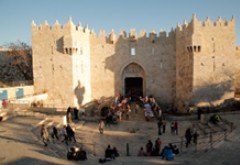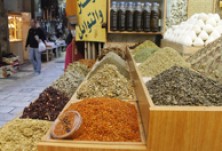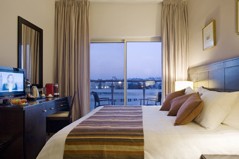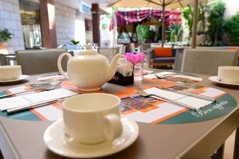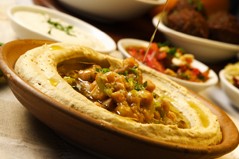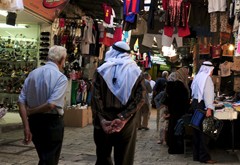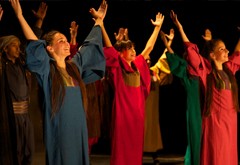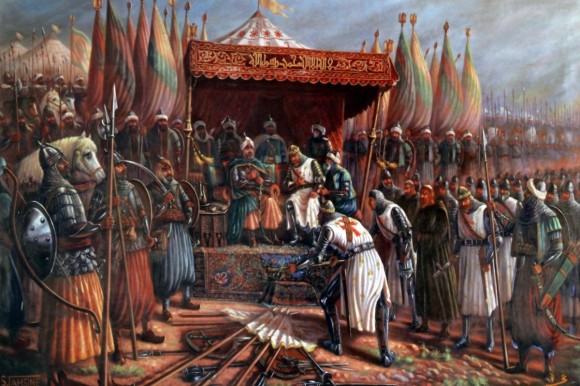In a vast meadow south of France named Clairmont, Pope Urban II stood before his congregation in 1095 instigating European Christians to liberate Christ's Tomb from the hold of Arab Muslims. As a result of this call, and for various other reasons, European armies headed, wearing the cross logo on their uniforms, and accompanied by thousands of mobs, poor people and the princes of Europe in search of the wealth of the orient and new feudal regions, in a campaign referred to as the "armed pilgrimage" to Jerusalem, later to be known as the "Franks' War" or the "Crusades" in western sources. These forces reached the walls of Jerusalem in 1099, after establishing two fiefdoms in Al-Raha and Tripoli in Greater Syria.
The siege of Jerusalem was severe, and the city persevered for 40 days, after its attackers attempted to starve its people while subjecting them to all kinds of pressures. As resistance waned, the walls fell before the crusader war machine, and a horrible massacre was committed, at which the killers themselves shuddered. According to estimates by the Franks themselves, tens of thousands of Muslims and a few hundred Jews perished.
This "cultural" massacre extended also to every aspect of life. In addition to sacking the city, almost every Islamic building outside Al-Haram Al-Sharif, as well as many eastern churches, were destroyed. The Dome of the Rock, which dazzled its conquerors, was turned into a church and called Templum Domini, or the Temple of Abraham, while Al-Aqsa Mosque was turned into a church, an administrative center, headquarters for the Latin king, and a home for the Knights of Templar, as well as an arms depot. The eastern basement of Al-Aqsa Mosque, currently called the Marwani Prayer Hall, was turned into stables for their horses, called "Solomon's Stables." As for the Amalfi traders' complex, located in the Tannery / Mouristan, it was turned into the headquarters of the Knights Hospitaller, or the Sovereign Military Order of Malta. Later on, a new palace was built for the king in the Jerusalem Citadel. Hence, Jerusalem became the capital of the Latin Kingdom of Jerusalem, separated from a long history in which it was connected to a number of international empires.
The change in Jerusalem was dramatic during the Franks period, with a large number of churches, public buildings, and markets built inside the city walls, on top of the remains of Roman, Byzantine, Umayyad, Abbasid, and Fatimid buildings. The western romantic style was introduced, and later on, the early Gothic style. The names of the gates and streets of the city were changed, and a semi-total replacement of the population was undertaken, with Franks settling inside the city. Eastern Christians were also brought in from Palestine, Jordan and Syria to livein the city, in order to compensate for the large discrepancy in the Franks' population, whereby with only them living in the city, it looked like a small village.
The Franks' settlement inside the city walls was concentrated in the area surrounding the Church of the Holy Sepulcher, later on called the Patriarch's sector, and around Al-Haram Al-Sharif. Eastern Christians, particularly from Jordan, and including those remaining in Jerusalem or returning to it, lived in the Sa'diyyah neighborhood, known at the time as Al-Mashariqah (easterners) neighborhood, while other neighborhoods were left completely deserted. The number of Arminians living in the quarter named after them also increased, and later on, small neighborhoods emerged for ethnic European groups who resided in Jerusalem, such as the German, Spanish, Hungarian, Bulgarian, Greek, Georgian, and Brittanic neighborhoods, as well as others. A neighborhood, in this context, may simply be a church, a hostel, and a few buildings surrounding them.
The population of Jerusalem towards the end of the Franks' period reached about ten thousand, and the population of the Armenian quarter increased gradually. Frank activity included building churches and convents, in addition to a large number of hostels to accommodate the new arrivals, who came in incessant waveswhich did not abate until two centuries later, in addition to the pilgrimage movement which also increased in pace. It also included rebuilding large sections of the Church of the Holy Sepulcher and the St. Anne's Church (Al-Salahiyyah School), in addition to dozens of churches inside and outside the city walls. In fact, the Franks paid much attention to the city Souqs (markets), rebuilding some of them, and adding new ones, in order to activate the economy and to fulfill the ever-increasing requirements of the Christian pilgrims. It may be considered that the size of the Old City, with some minor Ottoman changes, was settled during this period.
The fall of Jerusalem caused a great deal of bitterness throughout the Islamic world, with residents of Jerusalem, together with refugees from all of Palestine, who fled the invasion and the killing, travelling throughout the Muslim countries provoking people to retrieve Jerusalem. As a result, a struggle movement was crystallized by Al-Zinki clan (EmadEddin and NourEddin), which eventually produced Salah Eddin Al-Ayyoubi, who stood before the walls of Jerusalem in 1187 AD after he vanquished the Franks in the Battle of Hiitin.
Jerusalem surrendered to Salah Eddin Al-Ayyoubi after 88 years of continued crusader control. He allowed its Franks residents to leave with their belongings, after paying a ransom, while he allowed Eastern Christians to stay. This had extensive repercussions around the Muslim world, particularly in Baghdad, where the Abbasid caliph was, and was widely celebrated, officially and at the popular levels in all Islamic regions.

